The C-More HMI Panel software uses virtual components called Objects. These objects are programmable to simulate the functions that you require on your automation project. Pushbuttons, switches, meters, and graphs are just a few of the objects that are available to you.
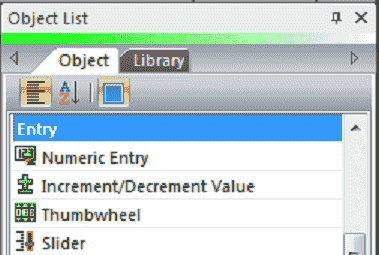
We will now look at the object entry that we can use with our HMI panel. The entry objects that are available on the C-More EA9 are Numeric Entry, Increment/Decrement Value, Thumbwheel, and Slider. Let’s get started.
Previously in this C-More EA9 HMI Panel series, we have done the following:
System Hardware
– Unboxing and Review Video
– Powering the Unit Video
Installing the Software – Video
System Setup Screens – Video
First Program
– Establishing Communication and Updating Firmware Video
– First Program Video
Panel to PLC and PLC to Panel Settings – Video
Common Screen Menu – Video
Simulate Project – Video
Object List Shapes – Video
Object List Buttons – Video
Object List Indicators – Video
Watch the video below to see the Object Entry in action on our C-More EA9 HMI Panel.
Setting Our C-More Object List Entry Page
We will be adding to the program we created last time. (C-More EA9 HMI Series Panel Object List Indicators).
Select a new screen under the main menu | Screen | New Screen…
Alternatively, we can also use the icons in the Navigation panel.
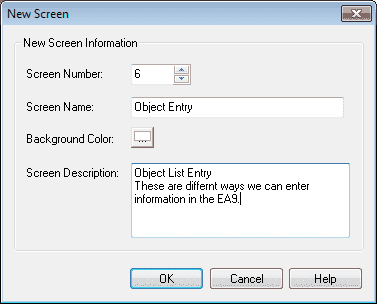
We will name the screen 6 Object Entry. The screen description can be used to describe the screen. Hit OK.
Our new screen will now be displayed.
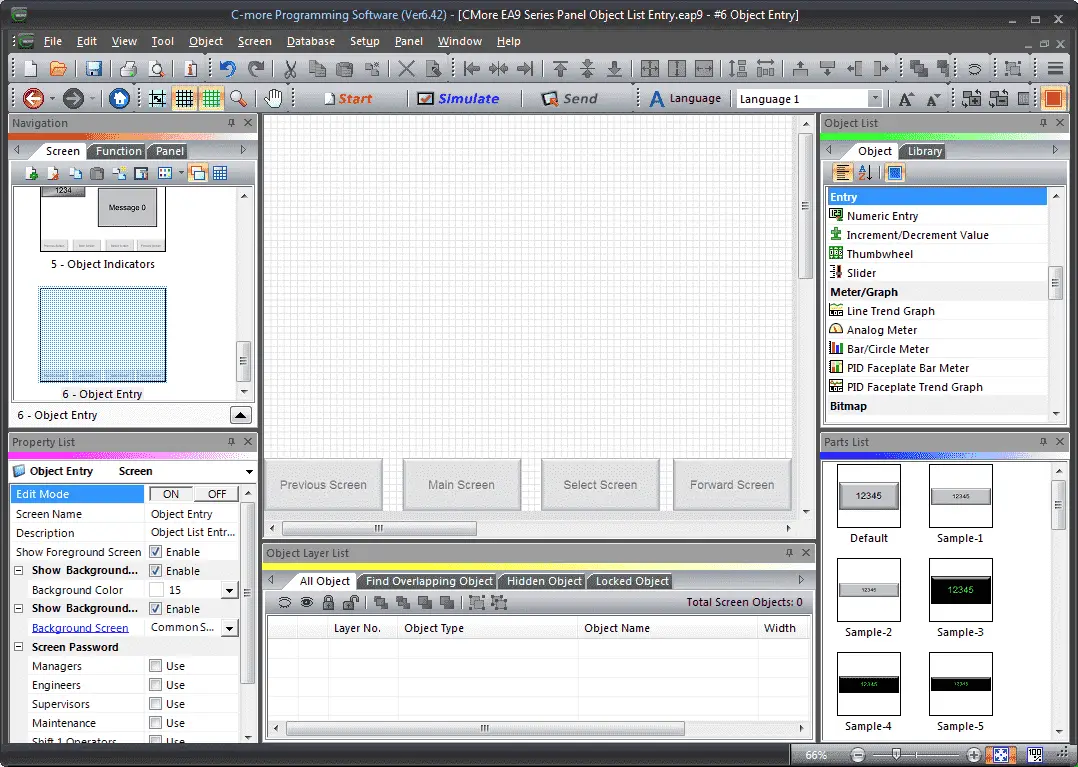
Under the property, list window turn on the editing and enable the show background. Select Common Screen Menu under the background screen. Turn off the edit mode under the property list.
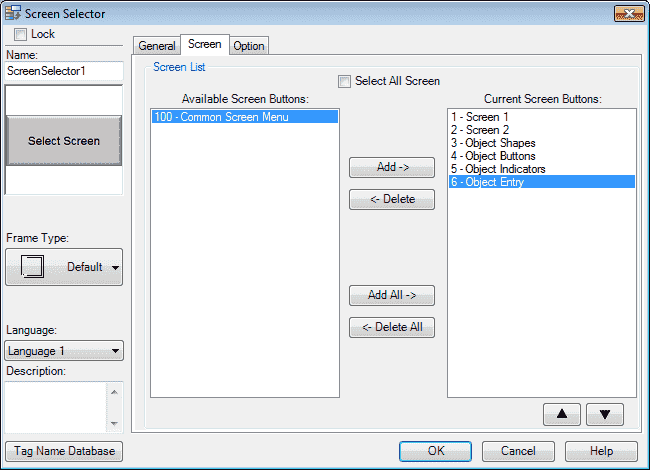
We must now add our new screen so we can select it when using the common screen menu. Select page 100. Select the Screen Selector button. Under the Screen, tab selects the 6 – Object Entry and hit the Add button so it moves it over to the Current Screen Buttons. Hit OK. We can now go back to our newly created Object Indicators screen page 6 from our navigation window.
Our new screen is now ready for us to add our indicators.
Tag Name Database
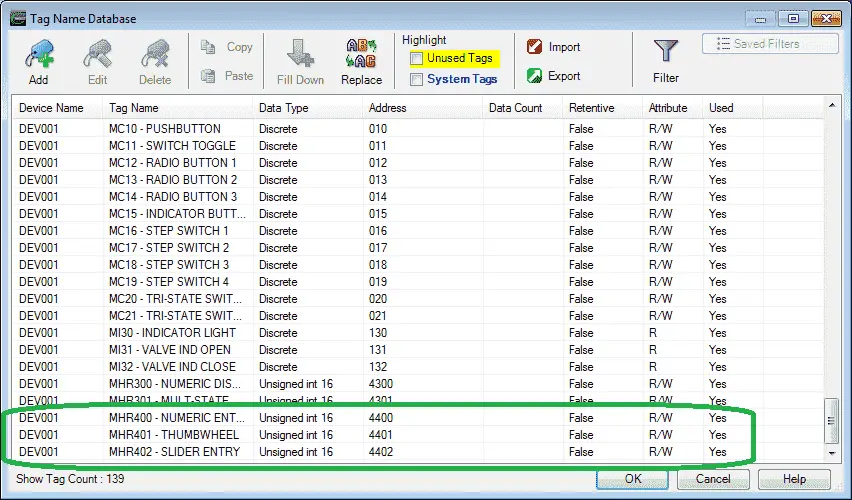
We will use the following addresses to control the entry objects on the cmore HMI.
MHR400 – Unsigned Int 16 – Modbus Address 40400 – Read / Write (Numeric Entry)
MHR401 – Unsigned Int 16 – Modbus Address 40401 – Read / Write (Thumbwheel Entry)
MHR402 – Unsigned Int 16 – Modbus Address 40402 – Read / Write (Slider Entry)
C-More List Entry Objects
Entry objects refer to words in the PLC that can display/change a numeric value on the HMI screen. The control of these tags is done with the HMI panel and communicated to the PLC program.
C-More Numeric Entry
Select Screen 6 from the navigation window. We will now add a Numeric Entry under the Object list window. Left click (hold) and drag the Sample-3 under the Parts List for the Numeric Entry onto the screen.
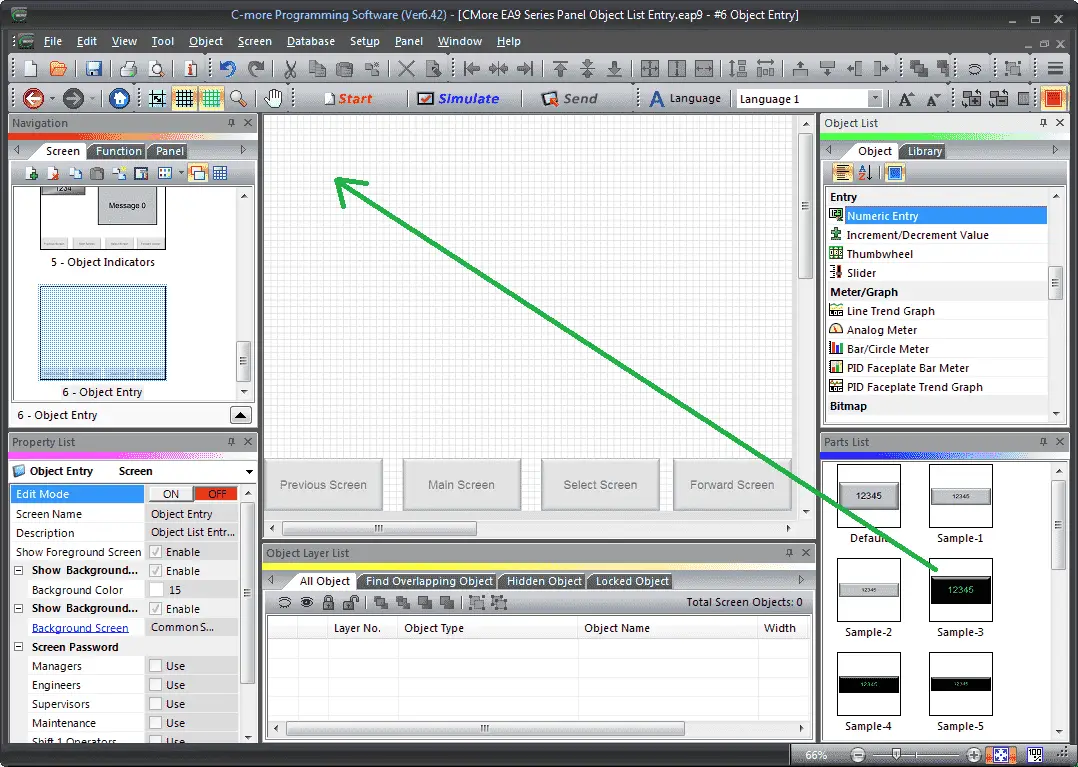
Note: Choose a preconfigured part from the Parts List window for the object selected. This will save time when configuring objects. Click and drag the item from the parts list to the screen. All of the objects will have a parts list.
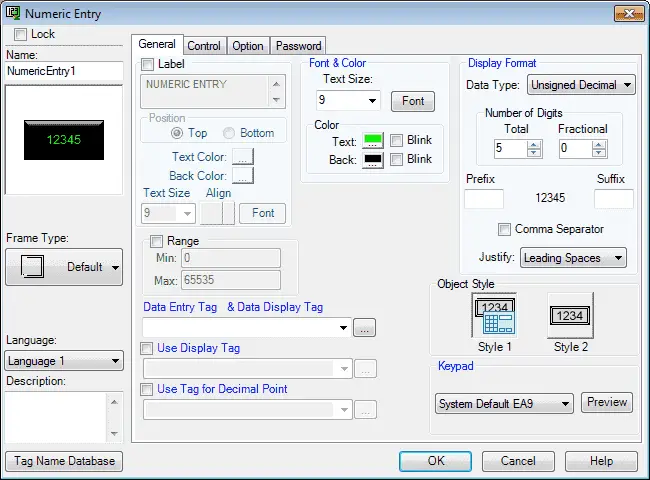
The Numeric Entry screen window will display. You can also use the main menu | Object | Entry | Numeric Entry… and click on the work area of the screen. This will give you the default numeric entry selection.
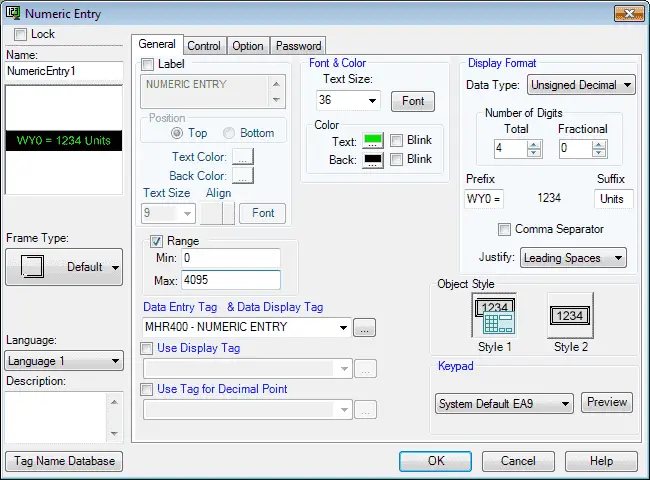
The following parameters can be set:
Name: This is the name of the object. The default is NumericEntry1
Object Preview Window: This will show what the object will look like on the screen.
Frame Type: The numeric entry object can be displayed in a series of frames. We will leave this as the default value.
Language: We will leave this as our default Language 1.
Description: We can enter up to 400 words to describe the purpose of the numeric entry that we are programming.
Tag Name Database: This will open a window that allows you to add, edit or delete tag names.
General Tab
Label: This will add a label to the numeric entry. We will not select this and leave the default name of NUMERIC ENTRY in the label text field.
Font & Color: This will allow us the change the text size, font, and colour. Change the text size to 36. We will leave the default values for the font, text and background colour.
Range: Select the range. This will allow us to limit the entry by the user. In our case, the minimum will be 0 and the maximum will be 4095.
Tag Name: This is the tag name of the PLC address of the numeric entry. The right button next to the drop-down menu will open a window that allows you to add, edit or delete tag names. Select MHR400 (Modbus Address 40400)
Note: Only the tags that can be used with the numeric entry are displayed.
You can also specify a separate display tag and tag for decimal point if your application requires these options.
Display Format
Data Type: This will specify the data type of our numeric entry. We will use unsigned decimal in our application.
Number of Digits: You can specify the total number of digits that you want to display. The fractional will display the decimal point position of the displayed total digits. In our case, we will set the total to 4 digits and 0 fractional.
Prefix – The prefix will display characters before the displayed number. In our case, we will specify the PLC address “WY0 =”.
Suffix – The suffix will display characters after the displayed number. This is ideal for indicating units of measurement for the number displayed. We will set this as “Units”.
Comma separator is used to include a comma to separate the 1000 units of measurement. This can help the user read the number clearly for larger numbers. We will leave this unchecked.
Justify: This is used to align the numbers on the display. We will leave this as ‘Leading Spaces’.
Object Style: We will leave this as the default of Style 1. Style 1 means we can use a popup keypad. In our case, we are using the System Default EA9 keypad. Style 2 refers to an external device such as a bar code reader or keyboard as the input data.
Select the control tab.
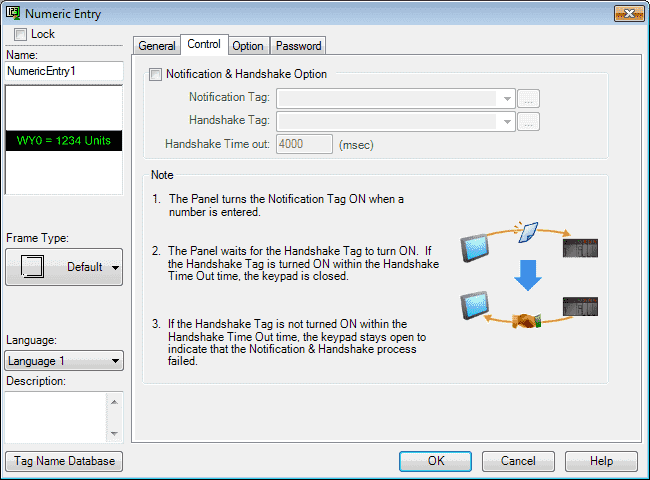
The Control Tab allows the programmer to configure Handshaking between the Panel and the PLC to ensure data is written at the specified time.
Notification Tag: The Notification Tag is the PLC Tag associated with a Bit to notify the PLC that a value has been entered. The C-more panel turns this bit ON when ENTER is pressed and C-more turns this bit OFF when either the Handshake Tag (ON) is read from the PLC or when the Handshake timer times out.
Handshake Tag: The Handshake Tag is the PLC Tag the PLC turns ON indicating that it has received the Notification Bit.
Handshake Timeout: If the Handshake Tag is not turned ON by the Controller in the amount of Time allowed by the Handshake Timeout field, a Handshake Timeout will occur.
Select the option tab.
Option Tab
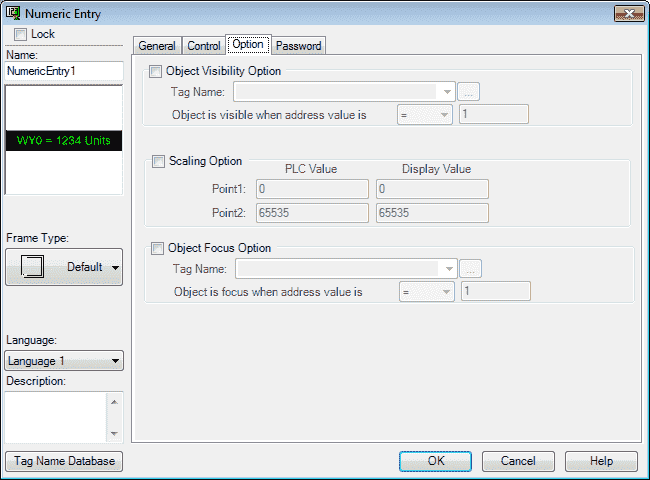
Object Visibility Option: We can use this selection to configure a tag to control when the object appears on the screen. C-More EA9 HMI Series Panel Object List Shapes – Video will demonstrate how we use this option.
Scaling Option: Scaling allows the PLC value entered in the Numeric Entry object to be displayed as a scaled value. The Data Display Tag value is scaled. We will not use this option.
Object Focus Option: This selection is available for the Numeric Entry and Text Entry objects. It requires that Style 2 is selected on the General Tab. Object Focus allows the input device, bar code reader, for example, to enter data without requiring the operator to select the Numeric/Text Entry Object on the screen.
Select the password tab.
Password Tab
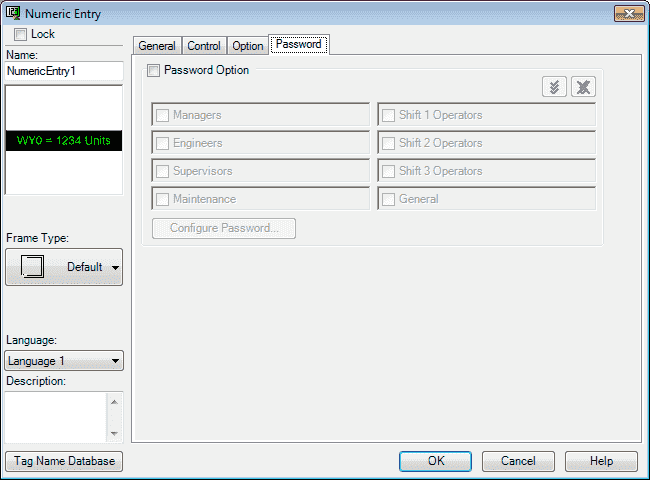
We can specify a password if required. In our example, we will not use this option.
Click OK.
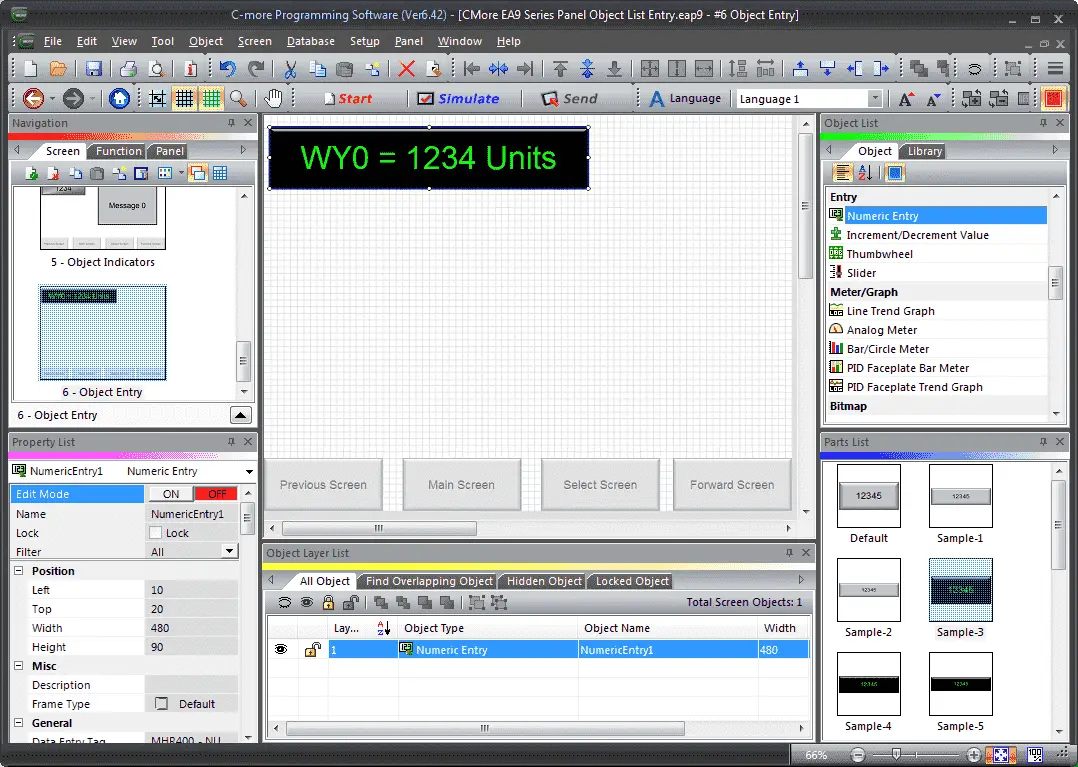
We can now position and resize the numeric entry object on our screen using our mouse.
C-More Increment / Decrement Value
The Increment/Decrement Value Object is used to Add or Subtract an amount to the value of a Tag Name by pressing a button on the HMI panel.
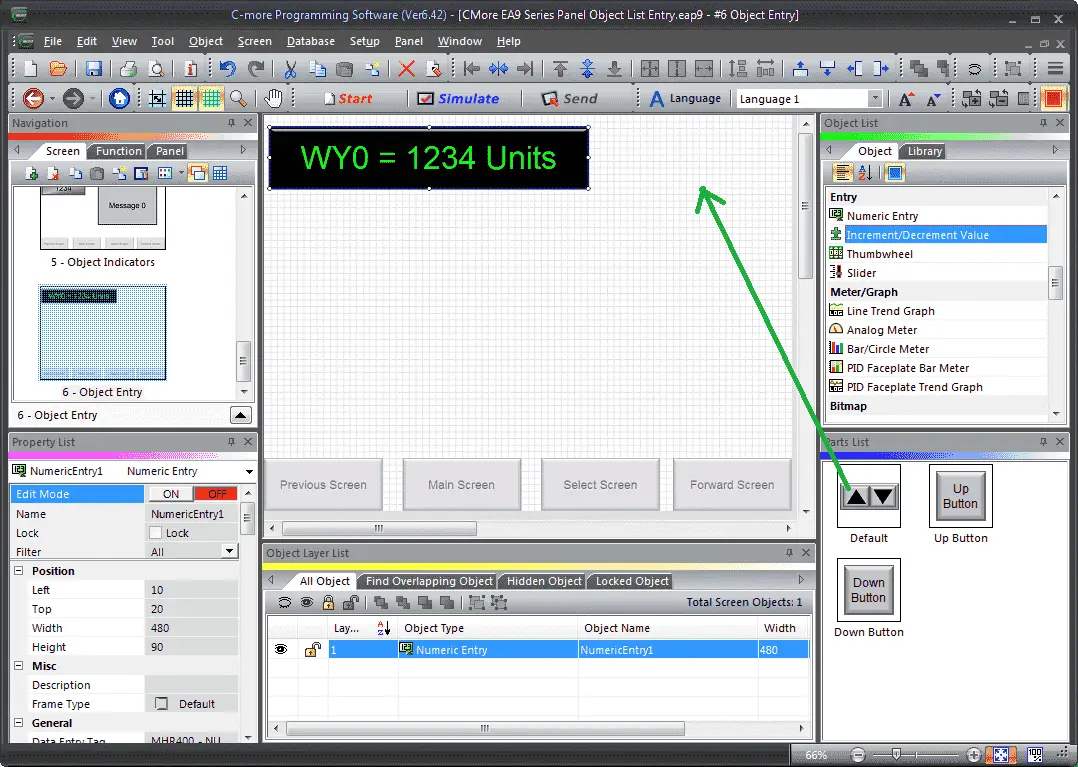
Select Increment/Decrement Value from the Object List under Entry. Now click and hold Default from the parts list and drag onto our screen.
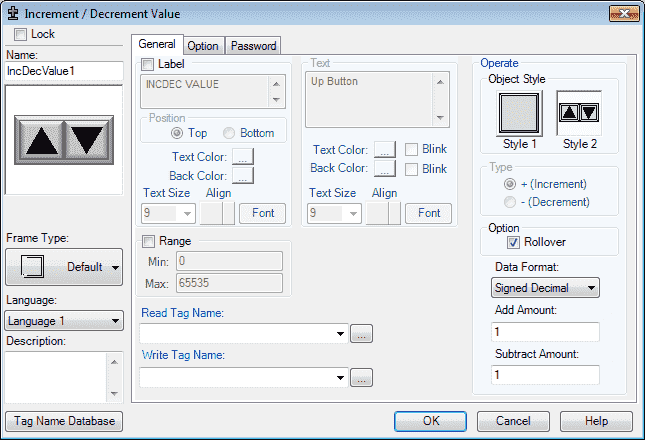
The Increment/Decrement Value window now appears. This is similar to many of the items that we have already programmed for the numeric entry object above.
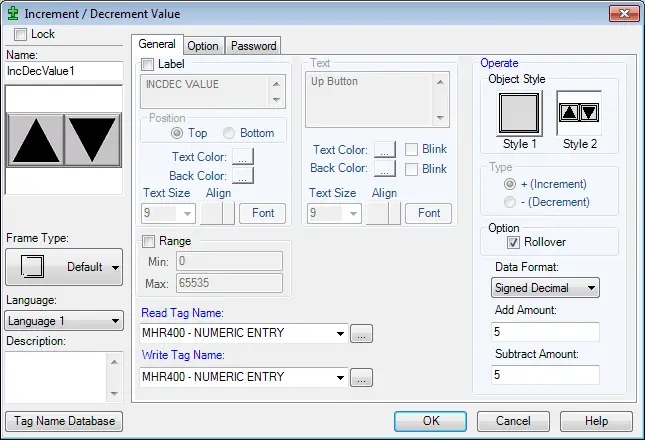
The Read and Write Tag Name is MHR400 (Modbus Address 40400). This means that we will be using the same memory location as the numeric entry above. The object style will be 2. Our data format is signed decimal and the add/subtract amounts are 5.
Select the option tab.
Option Tab
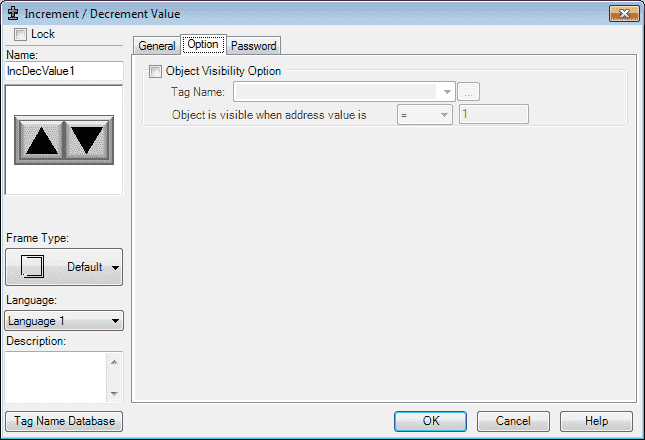
We can select the visibility if desired. In our case, we will not set this option.
Select the password tab.
Password Tab
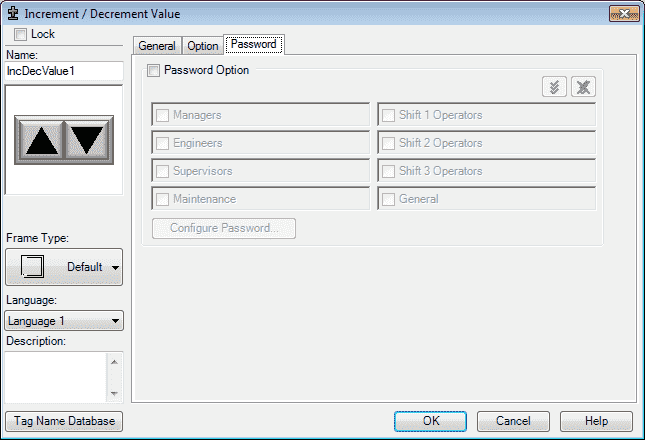
We can select the password options if desired. We will leave this off.
Select OK.
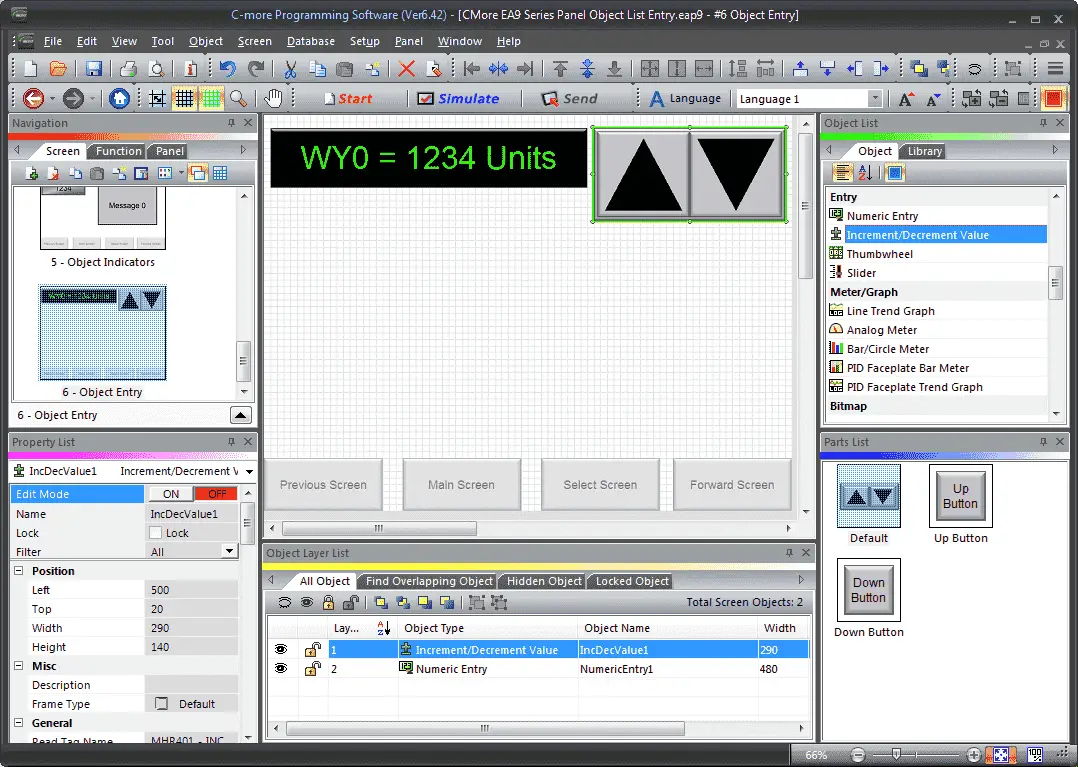
We can now use the mouse and size and move our increment/decrement value object.
C-More Thumbwheel
The Thumbwheel is a digital version of a mechanical Thumbwheel that may be found on a typical industrial control panel. This Object can be used to change a value by Incrementing or Decrementing the specific wheel number value by pressing on the Up or Down arrows for each number or wheel available. We will now add a thumbwheel object to our screen.
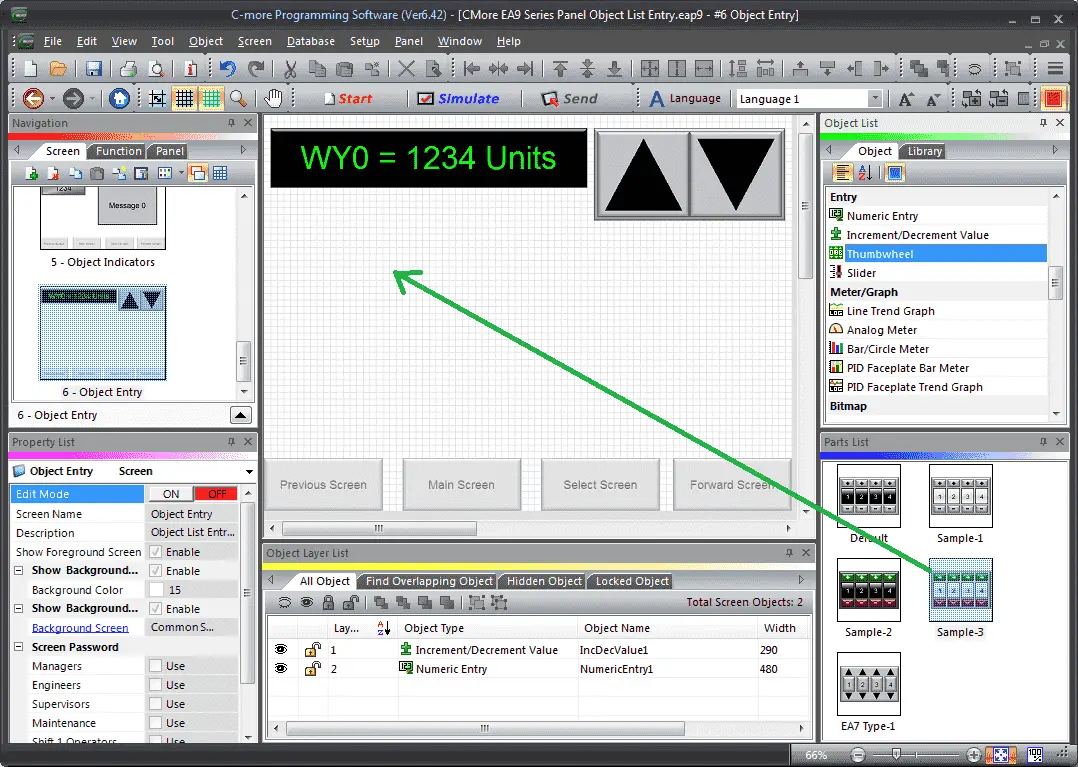
Select Thumbwheel from the Object List under Entry. Now click and hold Sample-3 from the parts list and drag onto our screen.
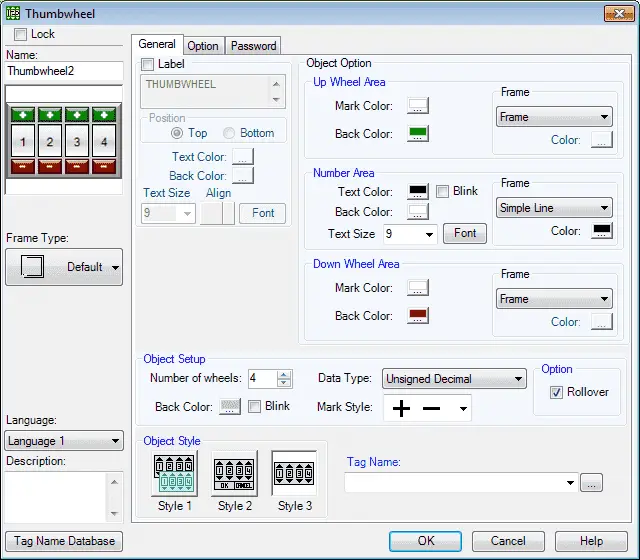
The thumbwheel window will now appear. The Thumbwheel Object is very similar to the Numeric Entry Object programmed above.
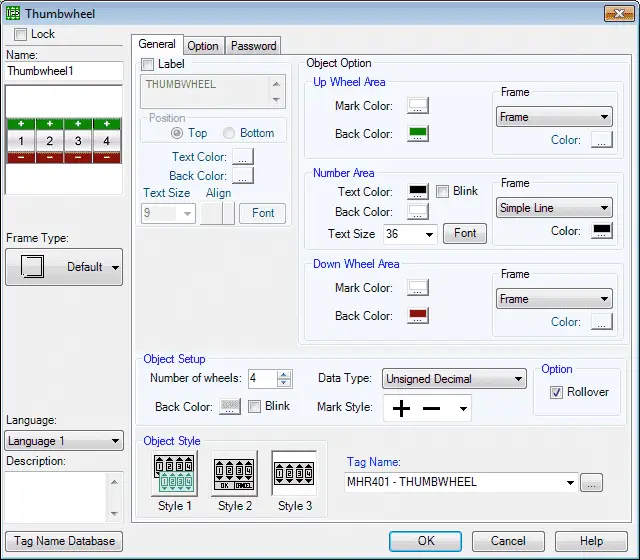
We will set the number area font size to 36. The number of wheels will be 4. We will leave everything else as the default.
Our Tag Name will be set for MHR401 (Modbus Address 40401)
Select the option tab.
Option Tab
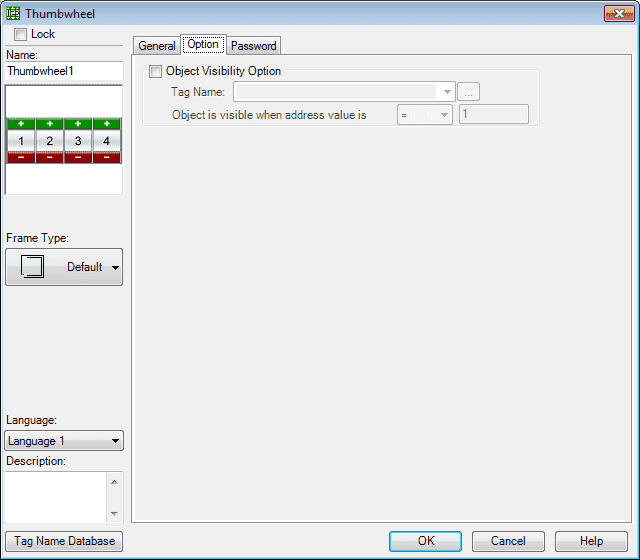
We will not use visibility.
Select the password tab.
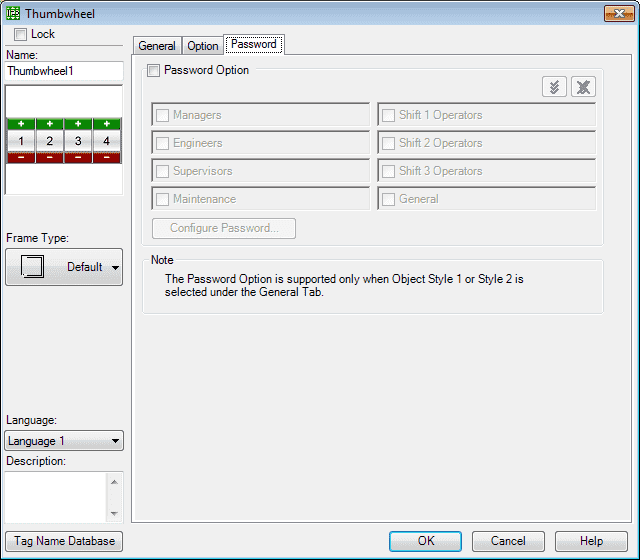
We will not use the password option.
Select OK
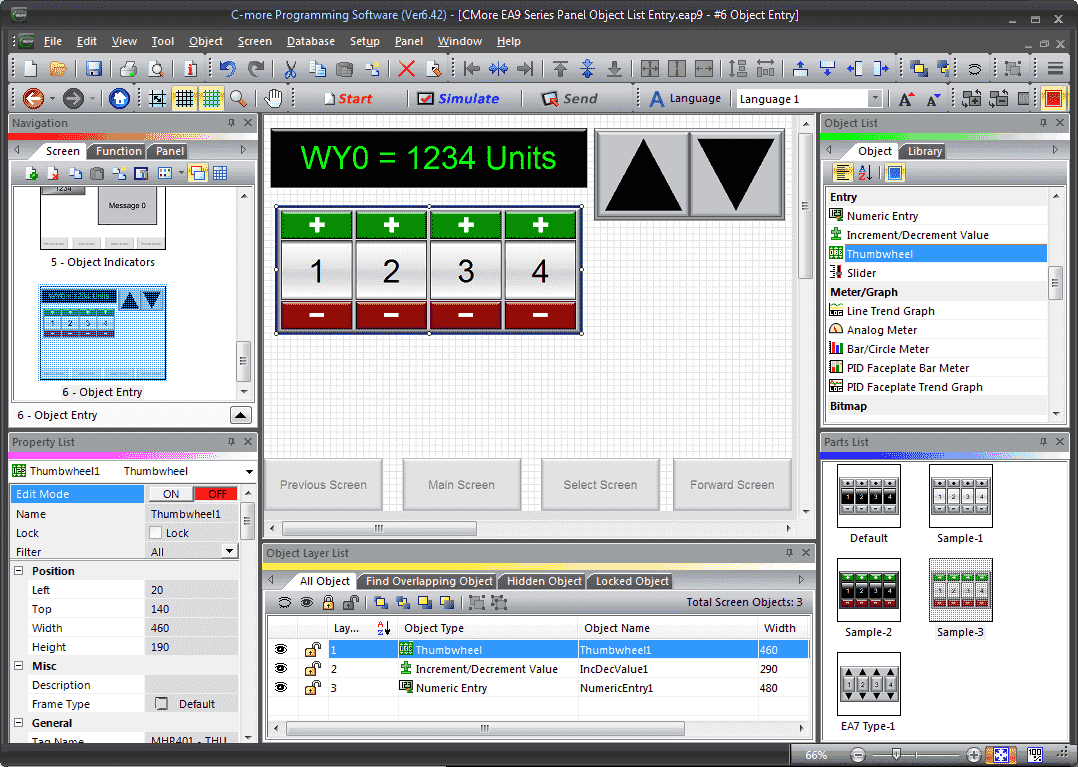
We can now use the mouse and size and move our thumbwheel object.
C-More Slider
The slider object will allow numeric values to change based upon a sliding control device similar to ones you would find on control panels.
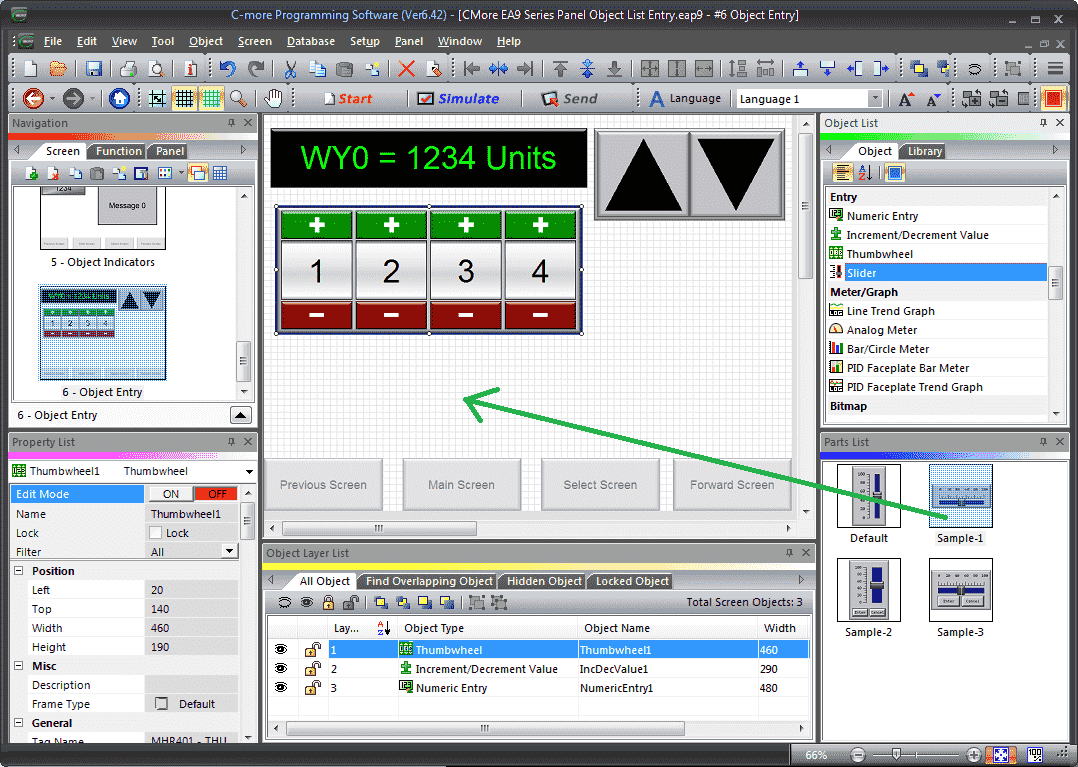
Select Slider from the Object List under Entry. Now click and hold Sample-1 from the parts list and drag it onto our screen.
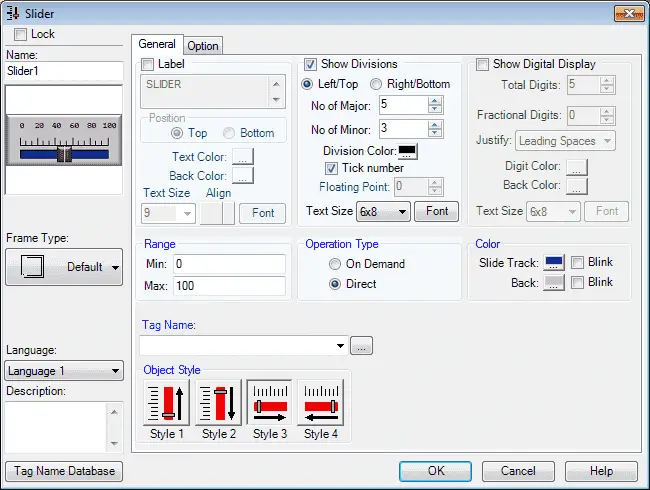
The slider window will now appear.
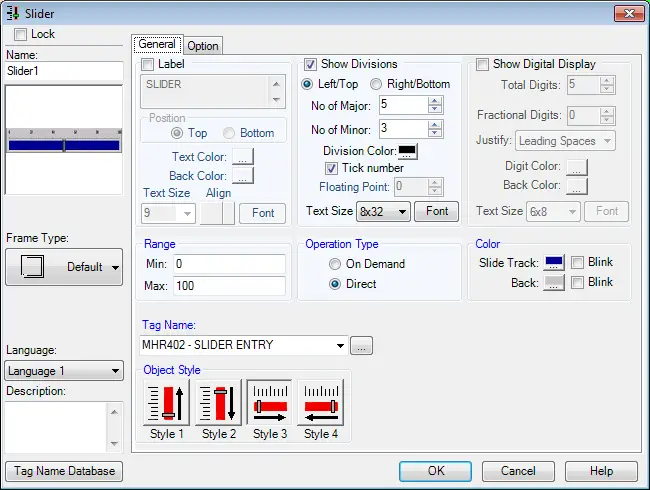
We will leave most of the settings on default. Under the text size, change this to 8×32.
We will set the Tag Name to MHR402. (Modbus Address 040402).
Select the option tab.
Option Tab
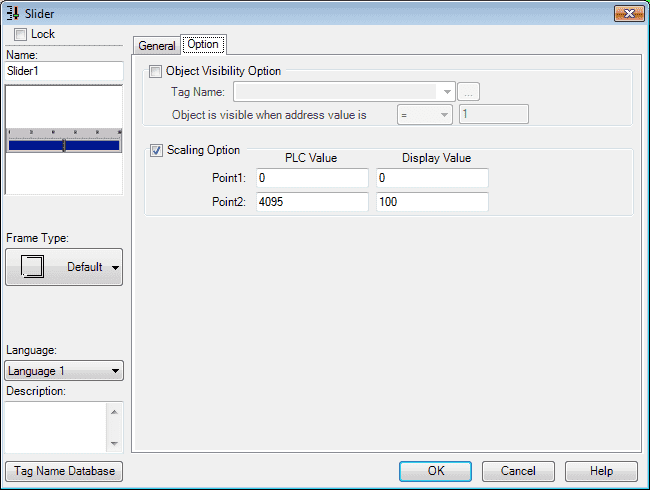
We will not use visibility.
Select the Scaling Option. When the display value changes from 0 to 100 this will change the tag information (PLC value) from 0 to 4095.
Select OK.
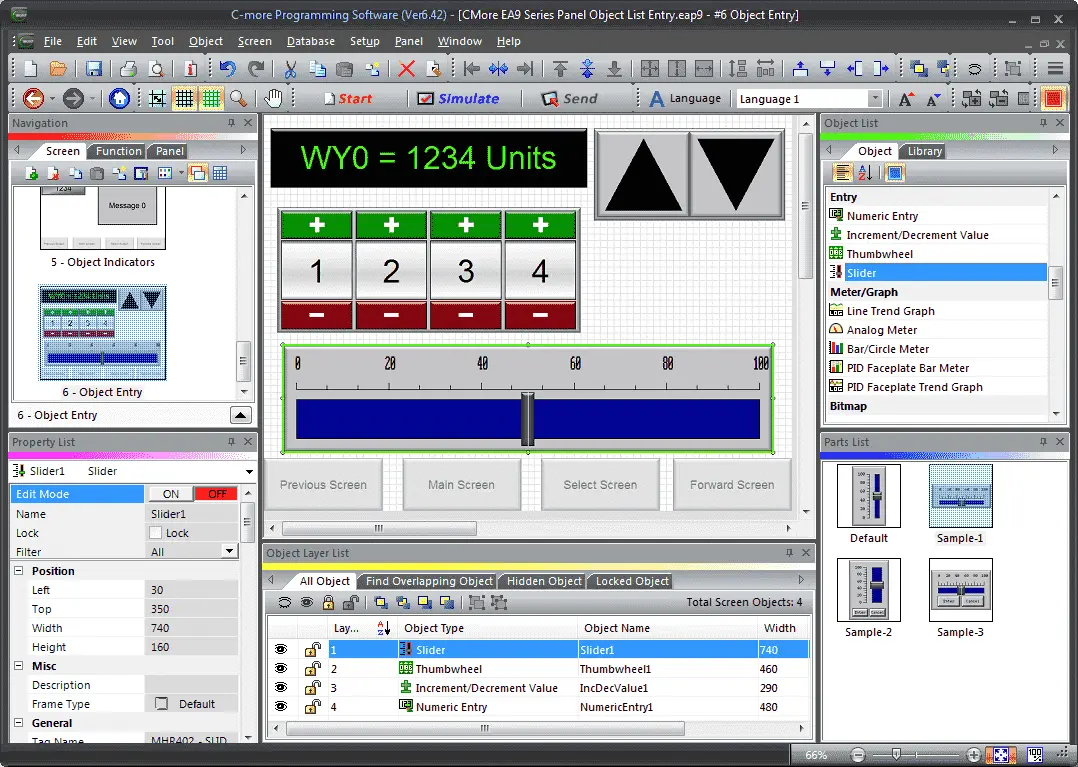
We can now use the mouse and size and move our slider object.
Simulate our C-More Object List Entry Project
We can use the simulator to view and try our entry objects. This will ensure the visual and address operations that we want in our program.
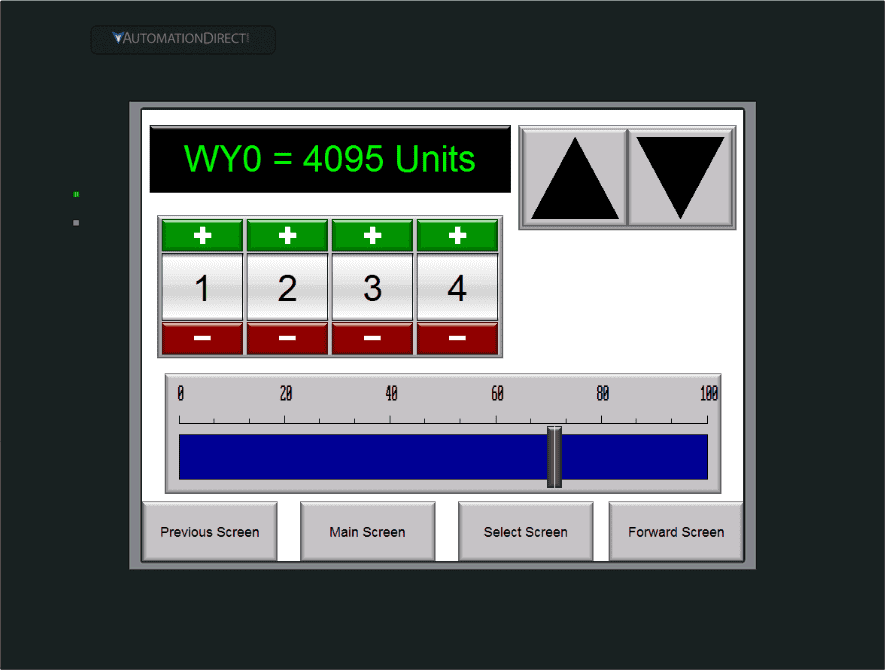
Here is what our keypad will look like on our HMI panel.
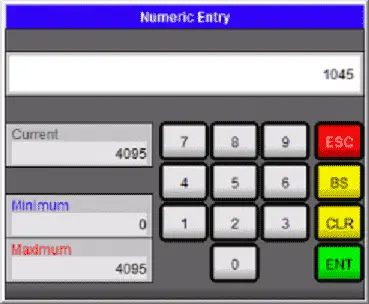
PLC Program Additions
Using the program we previously developed, we will add additional rungs to control the entry objects that we have just created.

Move MHR400 (Modbus 40400) to address WY0. WY0 has a range from 0 to 4095.

When we programmed the increment/decrement value object we did not put in any checks on the value entered. These lines of code will ensure that the value in MHR400 is between 0 and 4095.

Move MHR401 (Thumbwheel – Modbus 40401) to address WY1.

Move MHR402 (Slider – Modbus 40402) to address WY2. Scaling is done in the HMI. 0 to 100 represents 0 to 4095.
Download the PLC and C-More program here.
Watch the video below to see the Object Entry in action on our C-More EA9 HMI Panel. This will also demonstrate the PLC ladder code for functionality.
C-More EA9 Panels from Automation Direct
https://www.automationdirect.com/c-more/home
C-More – Graphic Panel (EA9 Series) User Manual and Quick Start Guides
https://cdn.automationdirect.com/static/manuals/ea9userm/ea9userm.html
EA9-T10CL C-More Specifications
https://cdn.automationdirect.com/static/specs/ea9t10cl.pdf
C-More EA9 Programming Software (Current Version V6.42)
https://support.automationdirect.com/products/cmore.html
This software will enable you to program all of the C-More EA9 HMI units. It includes a simulator for your application.
Next time we will look more at the object list Meter/Graph that we can use in the C-More HMI Panel.
Watch on YouTube: C-More EA9 HMI Series Panel Object List Entry
If you have any questions or need further information please contact me.
Thank you,
Garry
If you’re like most of my readers, you’re committed to learning about technology. Numbering systems used in PLC’s are not difficult to learn and understand. We will walk through the numbering systems used in PLCs. This includes Bits, Decimal, Hexadecimal, ASCII and Floating Point.
To get this free article, subscribe to my free email newsletter.
Use the information to inform other people how numbering systems work. Sign up now.
The ‘Robust Data Logging for Free’ eBook is also available as a free download. The link is included when you subscribe to ACC Automation.

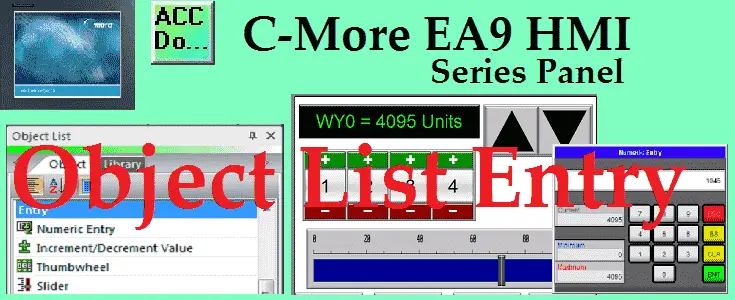

Hi , I have an physical thumbwheel and I would like to get rid of it and use the HMI but I’m not sure how to program it , thanks
Hi Humam,
The following post may help you out.
https://accautomation.ca/c-more-ea9-hmi-series-panel-object-list-entry/
There is even a thumbwheel input that will mimic the physical thumbwheel.
Regards,
Garry
What type of plc address should I use for the thumbwheel
Hi Humam,
The PLC address would depend on the brand of PLC that you are using. If this is an Automation Direct PLC, I would use an integer for the address. An Omron PLC would use BCD usually.
I hope this helps you out.
Regards,
Garry
It’s AB plc , and I’m using a move command but I get a fault with memory type Thanks for your help
Hi Humam,
Can you indicate the model of AB PLC that you are using? Also, can you attach a picture of the move command and error message that you are getting?
Here is some information on the Allen-Bradley Control/CompactLogix Tags for the C-More.
https://www.automationdirect.com/microsites/c-more/software-help/Content/128.htm
I hope this helps you out.
Regards,
Garry